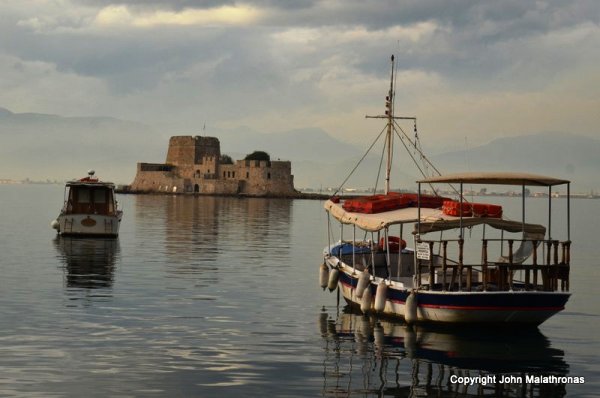I always enjoy the anticipation of the first-day’s stroll through a town I’ve just arrived at; that checking of camera batteries, the sorting out of maps and bookmarking of the guidebook. There are some places however, that enhance the experience. Nafplio is one.
I’ve often wondered what makes one city eminently walkable. Is it the encounter of different cultures embodied in the urban weft, like Barcelona? Nafplio certainly has a range, from Venetian to Ottoman to Neoclassical and beyond. Is it a change in the urban landscape, such as Rome with its seven hills? Nafplio, situated in the tip of a narrow bay inlet and watched over by two hills, fits the description. Is it the sense of living history one gets by historical osmosis? Nafplio’s three almighty castles visible from every pavement angle seamlessly blend the past into the present. Whatever the definition, Nafplio is a flaneur’s town.
Every time I come here, I discover a new side to this very first capital of modern Greece. Yes, Nafplio being both safe, bustling and populous was the first seat of government after the birth of the Greek state in 1829 during the revolt against the Turks. Only after Prince Otto came to reign as King over the Greeks did the romantic Bavarians choose the then small hamlet of Athens, cradle of Western culture, to become the capital of this new Oriental statelet.

There’s a walk that brings to memory those heady Nafplio days. What the town has in common with Athens is a “Syntagma Square” where I start my ramble, because it exemplifies the interspersing of styles and ideas that influenced the town. In the past this was the administrative square where the Serail of the Ottoman governor of the Peloponnese, Morea Pasha, used to be. The archaeological museum in the west with the Lion of St Mark above its gate, is an old Venetian granary, while the National Bank building in the south is a 1930s neoclassical gem. Today cafes, restaurants and pizzerias offer tables and seats for eating, drinking or people-watching depending on the hour of day.
Two old mosques also flank this beautiful square: to the East, the Trianón, now a cinema and an exhibition hall, while, to the south, there is the “Vouleftikón” mosque, seat of Greece’s first parliament. This was, after all, the largest hall in town at the time. It is said that it was built by a Turkish Aga to atone for a murder he committed: two young Venetian nobles arrived to Nafplio one day to look for a cache of gold their father had hidden when the town was still under Venetian control. They found it, but the Aga killed them and kept the treasure for himself. Yet his pangs of conscience were such that he built this enormous mosque, oversized for a town like Nafplio, to atone himself.
Staikopoulou Street leads east lined up with shops and shaded by overhanging bougainvillea. It’s punctuated by the discreet smell of jasmine, the aromatic plant de rigueur in this part of the world. I look at every side-street south and I see steep stairs going up to Akronafplia, the first acropolis of the city. Those without weak knees can climb up to the park on top and take a short path that encircles the hill and overlooks the secluded town beach of Arvanitia. According to another city legend, this is where the Turkish Pasha threw his Albanian guard off the cliff to their death on the beach below, suspecting them of treason during the Greek revolution.

Time stands still in Nafplio, still. I realize it when I veer south of Staikopoulou to the small, hidden church of St Spyridon. It is in front of this church that the first self-governing experiment in Greece ended bloodily on 27 September 1831 with the assassination of Greece’s First President, Yannis Kapodistrias by Maniot warlords. I look at the bullet holes that have been left as permanent scars on the white church paint. These bullets caused the Great Powers to reflect that Greece might be ungovernable and that peace would better be served with an imported Bavarian King.
King Otto’s throne in Byzantine purple is still preserved in the city’s Orthodox cathedral of St George, a few steps further down on Plapouta St. It is here that Kapodistrias lay in state, embalmed in Greece’s first pharmacy, one block up on Aghiou Konstantinou St. This is where I stop and look up at the grand Palamidi Castle that towers over the town and try to mentally negotiate its 857 steps (or 999 if you believe the arithmetic of lore). It served as the jail where Kapodistrias’ assassins were held.
Otto left for Athens in 1834 and, after five years as the capital, Nafplio returned to its provincial role. At the time, its citizens were outraged. But, looking at the globalised monster that Athens has become and the jewel of the Peloponnese that is Nafplio today, I know which one was the ultimate winner.
John Malathronas is a versatile travel writer and photographer who has published three narrative travelogues on Brazil, South Africa and Singapore, has written for popular newspapers and magazines and co-authored guidebooks for Michelin and the Rough Guides. He also writes on his own blog, The Jolly Traveller.
Why not take a look at our selection of our fly-drive holidays to explore Hidden Greece, including itineraries in the Peloponnese that take in Nafplio.





